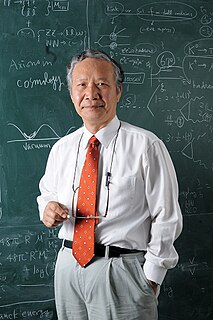In particle physics, a hadron is a composite subatomic particle made of two or more quarks held together by the strong interaction. They are analogous to molecules that are held together by the electric force. Most of the mass of ordinary matter comes from two hadrons: the proton and the neutron, while most of the mass of the protons and neutrons is in turn due to the binding energy of their constituent quarks, due to the strong force.

A quark is a type of elementary particle and a fundamental constituent of matter. Quarks combine to form composite particles called hadrons, the most stable of which are protons and neutrons, the components of atomic nuclei. All commonly observable matter is composed of up quarks, down quarks and electrons. Owing to a phenomenon known as color confinement, quarks are never found in isolation; they can be found only within hadrons, which include baryons and mesons, or in quark–gluon plasmas. For this reason, much of what is known about quarks has been drawn from observations of hadrons.
R-parity is a concept in particle physics. In the Minimal Supersymmetric Standard Model, baryon number and lepton number are no longer conserved by all of the renormalizable couplings in the theory. Since baryon number and lepton number conservation have been tested very precisely, these couplings need to be very small in order not to be in conflict with experimental data. R-parity is a symmetry acting on the Minimal Supersymmetric Standard Model (MSSM) fields that forbids these couplings and can be defined as

The Minimal Supersymmetric Standard Model (MSSM) is an extension to the Standard Model that realizes supersymmetry. MSSM is the minimal supersymmetrical model as it considers only "the [minimum] number of new particle states and new interactions consistent with phenomenology". Supersymmetry pairs bosons with fermions, so every Standard Model particle has a superpartner yet undiscovered. If discovered, such superparticles could be candidates for dark matter, and could provide evidence for grand unification or the viability of string theory. The failure to find evidence for supersymmetry using the Large Hadron Collider has strengthened an inclination to abandon it.
In particle physics, the Peccei–Quinn theory is a well-known, long-standing proposal for the resolution of the strong CP problem formulated by Roberto Peccei and Helen Quinn in 1977. The theory introduces a new anomalous symmetry to the Standard Model along with a new scalar field which spontaneously breaks the symmetry at low energies, giving rise to an axion that suppresses the problematic CP violation. This model has long since been ruled out by experiments and has instead been replaced by similar invisible axion models which utilize the same mechanism to solve the strong CP problem.
Hadronization is the process of the formation of hadrons out of quarks and gluons. There are two main branches of hadronization: quark-gluon plasma (QGP) transformation and colour string decay into hadrons. The transformation of quark-gluon plasma into hadrons is studied in lattice QCD numerical simulations, which are explored in relativistic heavy-ion experiments. Quark-gluon plasma hadronization occurred shortly after the Big Bang when the quark–gluon plasma cooled down to the Hagedorn temperature when free quarks and gluons cannot exist. In string breaking new hadrons are forming out of quarks, antiquarks and sometimes gluons, spontaneously created from the vacuum.

In particle physics, a three-jet event is an event with many particles in final state that appear to be clustered in three jets. A single jet consists of particles that fly off in roughly the same direction. One can draw three cones from the interaction point, corresponding to the jets, and most particles created in the reaction will appear to belong to one of these cones. These events are currently the most direct available evidence for the existence of gluons, and were first observed by the TASSO experiment at the PETRA accelerator at the DESY laboratory.
In particle physics, a rho meson is a short-lived hadronic particle that is an isospin triplet whose three states are denoted as
ρ+
,
ρ0
and
ρ−
. Along with pions and omega mesons, the rho meson carries the nuclear force within the atomic nucleus. After the pions and kaons, the rho mesons are the lightest strongly interacting particle, with a mass of 775.45±0.04 MeV for all three states.

Jonathan Richard Ellis is a British theoretical physicist who is currently Clerk Maxwell Professor of Theoretical Physics at King's College London.
The J. J. Sakurai Prize for Theoretical Particle Physics, is presented by the American Physical Society at its annual April Meeting, and honors outstanding achievement in particle physics theory. The prize consists of a monetary award, a certificate citing the contributions recognized by the award, and a travel allowance for the recipient to attend the presentation. The award is endowed by the family and friends of particle physicist J. J. Sakurai. The prize has been awarded annually since 1985.
In particle physics, NMSSM is an acronym for Next-to-Minimal Supersymmetric Standard Model. It is a supersymmetric extension to the Standard Model that adds an additional singlet chiral superfield to the MSSM and can be used to dynamically generate the term, solving the -problem. Articles about the NMSSM are available for review.
In particle physics, the lightest supersymmetric particle (LSP) is the generic name given to the lightest of the additional hypothetical particles found in supersymmetric models. In models with R-parity conservation, the LSP is stable; in other words, it cannot decay into any Standard Model particle, since all SM particles have the opposite R-parity. There is extensive observational evidence for an additional component of the matter density in the universe, which goes under the name dark matter. The LSP of supersymmetric models is a dark matter candidate and is a weakly interacting massive particle (WIMP).

Richard Keith Ellis, is a British theoretical physicist, working at the University of Durham, and a leading authority on perturbative quantum chromodynamics and collider phenomenology.
The eta and eta prime meson are isosinglet mesons made of a mixture of up, down and strange quarks and their antiquarks. The charmed eta meson and bottom eta meson are similar forms of quarkonium; they have the same spin and parity as the (light)
η
defined, but are made of charm quarks and bottom quarks respectively. The top quark is too heavy to form a similar meson, due to its very fast decay.
In quantum chromodynamics, the confining and strong coupling nature of the theory means that conventional perturbative techniques often fail to apply. The QCD sum rules are a way of dealing with this. The idea is to work with gauge invariant operators and operator product expansions of them. The vacuum to vacuum correlation function for the product of two such operators can be reexpressed as

Mikhail "Misha" Arkadyevich Shifman is a theoretical physicist, formerly at Institute for Theoretical and Experimental Physics, Moscow, currently Ida Cohen Fine Professor of Theoretical Physics, William I. Fine Theoretical Physics Institute, University of Minnesota.

Kim Jihn-eui is a South Korean theoretical physicist. His research interests concentrate on particle physics and cosmology and has many contributions to the field, most notably the suggestion of the invisible axion.

Stephan Narison is a Malagasy theoretical high-energy physicist specialized in quantum chromodynamics (QCD), the gauge theory of strong interactions. He is the founder of the Series of International Conferences in Quantum Chromodynamics (QCD-Montpellier) and of the Series of International Conferences in High-Energy Physics (HEPMAD-Madagascar).
Alberto Sirlin was an Argentine theoretical physicist, specializing in particle physics.
In quantum field theory, a contact term is a radiatively induced point-like interaction. These typically occur when the vertex for the emission of a massless particle such as a photon, a graviton, or a gluon, is proportional to . This factor cancels the of the Feynman propagator, and causes the exchange of the massless particle to produce a point-like -function effective interaction, rather than the usual long-range potential. A notable example occurs in the weak interactions where a W-boson radiative correction to a gluon vertex produces a term, leading to what is known as a "penguin" interaction. The contact term then generates a correction to the full action of the theory.








